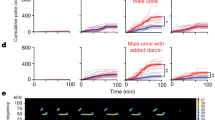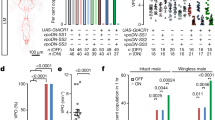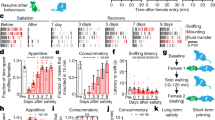Abstract
In rodents, social odor sensing influences female reproductive status by affecting neuroendocrine cascades. The odor of male mouse urine can induce ovulation or block pregnancy within 3 d post coitus. Females avoid the action of such olfactory stimuli after embryonic implantation. The mechanisms underlying these changes are unknown. Here we report that shortly after mating, a surge in dopamine in the mouse main olfactory bulb impairs the perception of social odors contained in male urine. Treatment of females at 6.5 d post coitus with a dopamine D2 receptor antagonist restores social odor sensing and favors disruption of pregnancy by inhibition of prolactin release, when administered in the presence of alien male urine odors. These results show that an active sensory barrier blocks social olfactory cues detrimental to pregnancy, consistent with the main olfactory bulb being a major relay through which social odor modulates reproductive status.
This is a preview of subscription content, access via your institution
Access options
Subscribe to this journal
Receive 12 print issues and online access
$209.00 per year
only $17.42 per issue
Buy this article
- Purchase on Springer Link
- Instant access to full article PDF
Prices may be subject to local taxes which are calculated during checkout







Similar content being viewed by others
References
Halpern, M. & Martinez-Marcos, A. Structure and function of the vomeronasal system: an update. Prog. Neurobiol. 70, 245–318 (2003).
Freeman, M.E., Kanyicska, B., Lerant, A. & Nagy, G. Prolactin: structure, function and regulation of secretion. Physiol. Rev. 80, 1523–1631 (2000).
Galosy, S.S. & Talamantes, F. Luteotropic actions of placental lactogens at midpregnancy in the mouse. Endocrinology 136, 3993–4003 (1995).
Erskine, M.S. Prolactin release after mating and genitosensory stimulation in females. Endocr. Rev. 16, 508–528 (1995).
Bruce, H.M. An exteroceptive block to pregnancy in the mouse. Nature 184, 105 (1959).
Rosser, A.E., Remfry, C.J. & Keverne, E.B. Restricted exposure of mice to primer pheromones coincident with prolactin surges blocks pregnancy by changing hypothalamic dopamine release. J. Reprod. Fertil. 87, 553–559 (1989).
Lloyd-Thomas, A. & Keverne, E.B. Role of the brain and accessory olfactory system in the block to pregnancy in mice. Neuroscience 7, 907–913 (1982).
Chung, H.J., Reyes, A.B., Watanabe, K., Tomogane, H. & Wakasugi, N. Embryonic abnormality caused by male pheromonal effect in pregnancy block in mice. Biol. Reprod. 57, 312–319 (1997).
Arkaravichien, W. & Kendle, K.E. Critical progesterone requirement for maintenance of pregnancy in ovariectomized rats. J. Reprod. Fertil. 90, 63–70 (1990).
Milligan, S.R. & Finn, C.A. Minimal progesterone support required for the maintenance of pregnancy in mice. Hum. Reprod. 12, 602–607 (1997).
Dulac, C. & Wagner, S. Genetic analysis of brain circuits underlying pheromone signaling. Annu. Rev. Genet. 40, 449–467 (2006).
Meisami, E. & Bhatnagar, K.P. Structure and diversity in mammalian accessory olfactory bulb. Microsc. Res. Tech. 43, 476–499 (1998).
Baker, H. Species differences in the distribution of substance P and tyrosine hydroxylase immunoreactivity in the olfactory bulb. J. Comp. Neurol. 252, 206–226 (1986).
Ennis, M. et al. Dopamine D2 receptor–mediated presynaptic inhibition of olfactory nerve terminals. J. Neurophysiol. 86, 2986–2997 (2001).
Coopersmith, R., Weihmuller, F.B., Kirstein, C.L., Marshall, J.F. & Leon, M. Extracellular dopamine increases in the neonatal olfactory bulb during odor preference training. Brain Res. 564, 149–153 (1991).
Harley, C.W. Norepinephrine and dopamine as learning signals. Neural Plast. 11, 191–204 (2004).
Yue, E.L., Cleland, T.A., Pavlis, M. & Linster, C. Opposing effects of D1 and D2 receptor activation on odor discrimination learning. Behav. Neurosci. 118, 184–190 (2004).
Halasz, N., Johansson, O., Hokfelt, T., Ljungdahl, A. & Goldstein, M. Immunohistochemical identification of two types of dopamine neuron in the rat olfactory bulb as seen by serial sectioning. J. Neurocytol. 10, 251–259 (1981).
Dluzen, D.E., Park, J.H. & Kim, K. Modulation of olfactory bulb tyrosine hydroxylase and catecholamine transporter mRNA by estrogen. Brain Res. Mol. Brain Res. 108, 121–128 (2002).
Arbogast, L.A. & Voogt, J.L. Progesterone reverses the estradiol-induced decrease in tyrosine hydroxylase mRNA levels in the arcuate nucleus. Neuroendocrinology 58, 501–510 (1993).
Tashiro, Y., Kaneko, T., Nagatsu, I., Kikuchi, H. & Mizuno, N. Increase of tyrosine hydroxylase–like immunoreactive neurons in the nucleus accumbens and the olfactory bulb in the rat with the lesion in the ventral tegmental area of the midbrain. Brain Res. 531, 159–166 (1990).
Thanky, N.R., Son, J.H. & Herbison, A.E. Sex differences in the regulation of tyrosine hydroxylase gene transcription by estrogen in the locus coeruleus of TH9-LacZ transgenic mice. Brain Res. Mol. Brain Res. 104, 220–226 (2002).
Wersinger, S.R. & Baum, M.J. Sexually dimorphic activation of midbrain tyrosine hydroxylase neurons after mating or exposure to chemosensory cues in the ferret. Biol. Reprod. 56, 1407–1414 (1997).
Wei, C.J., Linster, C. & Cleland, T.A. Dopamine D(2) receptor activation modulates perceived odor intensity. Behav. Neurosci. 120, 393–400 (2006).
Keller, M., Pierman, S., Douhard, Q., Baum, M.J. & Bakker, J. The vomeronasal organ is required for the expression of lordosis behaviour, but not sex discrimination in female mice. Eur. J. Neurosci. 23, 521–530 (2006).
Spehr, M. et al. Essential role of the main olfactory system in social recognition of major histocompatibility complex peptide ligands. J. Neurosci. 26, 1961–1970 (2006).
Meredith, M. Vomeronasal, olfactory, hormonal convergence in the brain. Cooperation or coincidence? Ann. NY Acad. Sci. 855, 349–361 (1998).
Yoon, H., Enquist, L.W. & Dulac, C. Olfactory inputs to hypothalamic neurons controlling reproduction and fertility. Cell 123, 669–682 (2005).
Boehm, U., Zou, Z. & Buck, L.B. Feedback loops link odor and pheromone signaling with reproduction. Cell 123, 683–695 (2005).
Brennan, P.A. & Zufall, F. Pheromonal communication in vertebrates. Nature 444, 308–315 (2006).
Halem, H.A., Cherry, J.A. & Baum, M.J. Central forebrain Fos responses to familiar male odors are attenuated in recently mated female mice. Eur. J. Neurosci. 13, 389–399 (2001).
Choi, G.B. et al. Lhx6 delineates a pathway mediating innate reproductive behaviors from the amygdala to the hypothalamus. Neuron 46, 647–660 (2005).
Pierman, S., Douhard, Q. & Bakker, J. Evidence for a role of early oestrogens in the central processing of sexually relevant olfactory cues in female mice. Eur. J. Neurosci. 27, 423–431 (2008).
Marchlewska-Koj, A. Pheromones and mammalian reproduction. Oxf. Rev. Reprod. Biol. 6, 266–302 (1984).
Robarts, D.W. & Baum, M.J. Ventromedial hypothalamic nucleus lesions disrupt olfactory mate recognition and receptivity in female ferrets. Horm. Behav. 51, 104–113 (2007).
Lehmann, M.L. & Erskine, M.S. Glutamatergic stimulation of the medial amygdala induces steroid-dependent c-fos expression within forebrain nuclei responsive to mating stimulation. Neuroscience 136, 55–64 (2005).
Keller, M., Douhard, Q., Baum, M.J. & Bakker, J. Destruction of the main olfactory epithelium reduces female sexual behavior and olfactory investigation in female mice. Chem. Senses 31, 315–323 (2006).
Mandiyan, V.S., Coats, J.K. & Shah, N.M. Deficits in sexual and aggressive behaviors in Cnga2 mutant mice. Nat. Neurosci. 8, 1660–1662 (2005).
Pro-Sistiaga, P. et al. Convergence of olfactory and vomeronasal projections in the rat basal telencephalon. J. Comp. Neurol. 504, 346–362 (2007).
La Vaque, T.J. & Rodgers, C.H. Recovery of mating behavior in the female rat following VMH lesions. Physiol. Behav. 14, 59–63 (1975).
Arey, B.J., Averill, R.L. & Freeman, M.E. A sex-specific endogenous stimulatory rhythm regulating prolactin secretion. Endocrinology 124, 119–123 (1989).
Mathiasen, J.R. & Voogt, J.L. Differential regulation of the nocturnal and diurnal prolactin surges in pregnant rats revealed by dopamine receptor antagonism. Neuroendocrinology 56, 704–711 (1992).
Keverne, E.B. & de la Riva, C. Pheromones in mice: reciprocal interaction between the nose and brain. Nature 296, 148–150 (1982).
Ma, D. et al. Selective ablation of olfactory receptor neurons without functional impairment of vomeronasal receptor neurons in OMP-ntr transgenic mice. Eur. J. Neurosci. 16, 2317–2323 (2002).
Martel, K.L. & Baum, M.J. Sexually dimorphic activation of the accessory, but not the main, olfactory bulb in mice by urinary volatiles. Eur. J. Neurosci. 26, 463–475 (2007).
Rajendren, G. & Dominic, C.J. Evaluation of involvement of accessory olfactory (vomeronasal) system in estrous cyclicity and mating in female mice. Indian J. Exp. Biol. 24, 573–577 (1986).
Whitten, W.K. The effect of removal of the olfactory bulbs on the gonads of mice. J. Endocrinol. 14, 160–163 (1956).
Lamond, D.R. Infertility associated with extirpation of the olfactory bulbs in female albino mice. Aust. J. Exp. Biol. Med. Sci. 36, 103–108 (1958).
Lin, D.Y., Zhang, S.Z., Block, E. & Katz, L.C. Encoding social signals in the mouse main olfactory bulb. Nature 434, 470–477 (2005).
Xu, F. et al. Simultaneous activation of mouse main and accessory olfactory bulbs by odors or pheromones. J. Comp. Neurol. 489, 491–500 (2005).
Acknowledgements
We are grateful to M. Hamon and F. Saurini (INSERM U288) for the tissue dopamine dosage and C. Sciarretta for comments. C.S. was supported by an EMBO fellowship.
Author information
Authors and Affiliations
Contributions
C.S. planned and performed most of the experiments and, together with L.M., drafted the manuscript. V.T. conducted the c-Fos experiment with the help of J.K.-B. and provided conceptual input. J.K.-B. also contributed to the PRL dosage experiments. M.A.B. provided the expertise for and helped conduct the behavioral experiments. L.M. is the PI; she contributed to the experimental plans, supervised the project, provided theoretical input and wrote the manuscript.
Corresponding author
Supplementary information
Supplementary Text and Figures
Supplementary Figures 1–3 and Supplementary Methods (PDF 196 kb)
Rights and permissions
About this article
Cite this article
Serguera, C., Triaca, V., Kelly-Barrett, J. et al. Increased dopamine after mating impairs olfaction and prevents odor interference with pregnancy. Nat Neurosci 11, 949–956 (2008). https://doi.org/10.1038/nn.2154
Received:
Accepted:
Published:
Issue Date:
DOI: https://doi.org/10.1038/nn.2154
This article is cited by
-
Identification of loci associated with conception rate in primiparous Holstein cows
BMC Genomics (2019)
-
Association of monoamine oxidase-A genetic variants and amygdala morphology in violent offenders with antisocial personality disorder and high psychopathic traits
Scientific Reports (2017)
-
Absence of M-Ras modulates social behavior in mice
BMC Neuroscience (2015)
-
Trojan Genes or Transparent Genomes? Sexual Selection and Potential Impacts of Genetically Modified Animals in Natural Ecosystems
Evolutionary Biology (2014)
-
The problem of pseudoreplication in neuroscientific studies: is it affecting your analysis?
BMC Neuroscience (2010)



